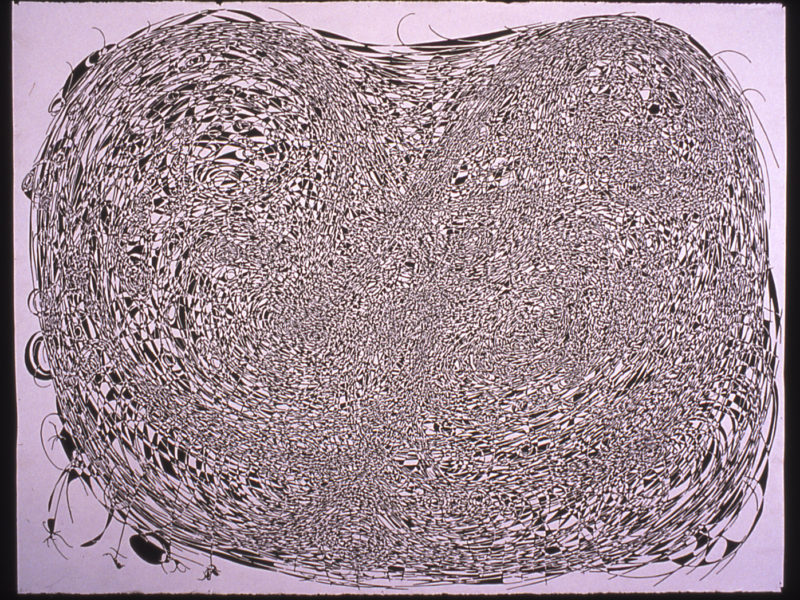Archive
Andrew Groocock, Monica Vidal, Marco Villegas, and Allison Wieseis Long Division
Curated by Eleanor Williams
The story of Lawndale’s transition from University of Houston to its current home at4912 Main Street reflects the vision of artists and patrons and a uniquely “can do” Houston attitude. Lawndale has gone through periods that I compare to the universal experience of trying to learn long division followed by the full gratification of figuring it out. As people grace the doors of the renovated building, many deserve to feel proud to stand there and marvel at the evolution of Lawndale as it enters its 25th anniversary year.
The beauty of division lies in taking hold of an idea and breaking it into its parts.Lawndale has always done so by creating often first-time opportunities: for artists to be included in exhibitions, for attendees to view debut exhibitions, for audiences to attend timely lectures and many annual and special events all shared by Houston’s diverse communities.
Lawndale has completed its long division problem of needing a permanent home. Now what lies ahead is the stability to continue to serve asa non-profit alternative space for the exhibition of contemporary works in all media, unique in its focus on Houston area artists. For this exhibition inaugurating the opening of the building after a million-dollar plus renovation, four artists have been selected. Each has previously been featured in solo exhibitions at Lawndale’s 4912 Main Street location and has created new work specifically for this exhibition.
Long Division: Andrew Groocock, Monica Vidal, Marco Villegas, and Allison Wieseis a metaphor for the private practice observed by each of these artists. Each responds to outside influences and interests that affect the ultimate outcome of their physical work.Respectively, each artist begins with an idea, be it physical or conceptual, and addresses geometry, form, architecture and history.
Andrew Groocock’s work is low-tech industrial design investigating geometry not from mathematics but from a visual approach. Color is a facilitator defining space as a primary experience. For the first time in one monumental work he reduces his sculpture to the simplest form by eliminating color, leaving a white structure ascending and descending from ceiling to floor. Because he is intrigued by how things fit together, Groocock’s modules often change each time a work is installed. This allows new reference points for space, shadow and pictorial plane not unlike the rearrangement of numbers through equations. The work is entitledTheNorth Face of The Eiger/ ClusterVariants.The physicality of the structure is created from two forms balancing on a series of offset “steps.” In reference to the work literally climbing the wall, Groocock himself says, “It was the challenge and the adventure. Sounds like mountaineering rather than making art.” As personal insight into the inspiration behind the work, Groocock has written a dissertation entitledMan and Animal as Machine and has a collection of over300 robots.
Marco Villegas creates paintings more as objects than pictures. Each work becomes a horizontal landscape as pixilated planes; osculating color in front remains parallel, giving life to empty landscape. His shaped canvases allow things to shift, eliminating spaces and creating new forms. The canvas itself becomes boxes unfolding. They repeat technology, for example font serifs breaking words down to the details of letters. Color contains subtleties with no immediate meaning but simply invites the viewer to stare and contemplate. Marco Villegas says, “Anything you stare at long enough becomes abstacted–like a word repeated over and over loses its meaning.” A new language emerges in Villagas’ visual vocabulary with two-dimensional flat surfaces shifting and creating odd contradictions going beyond initial expectations. With time each painting becomes a pleasant surprise.
Landscape, surface, skin, hair and texture comprise the related unbroken forms that exist in Monica Vidal’s work. The materials she utilizes appear to give her pleasure with each gesture and mark.Three distinct movements osculate each applicable plane suggesting a loose interpretation signifying surface, design, sewing and topographical investigation.According to Monica Vidal, “People look at my work and they see landscape, maps, topography, inkblots, and more recently, hair and knots. When I look at my work I see two things: my pursuit of technical excellence and an unwavering structural core. The true nature of my work is the navigation between and through these two ideas. The process itself comes from a desire for harmony that is unattainable, indeed unlivable, in the real world. Life is messy and fallible, so I pursue ideals of line and form.”
I wish credit could be given to the unknown photographer of the image on the front this brochure. It was passed on to Lawndale by Asa Weldon, whose family owned theWeldon Cafeteria originally located in the building as documented in this nocturnal view.To the right in neon, “Joe & Louie’s Nite Club” is being promoted with what I can only hope was a flashing arrow pointing to the third-floor speakeasy. In a small way this image was a jumping off point for Alison Wiese’s large-scale neon signage for the front façade of Lawndale Art Center, which displays a classic 20th-century labor movement slogan, An Injury to One is an Injury to All. Allison Wiese states, “Neon is usually strongly associated with commercial communication, and Lawndale’s building historically sported multiple neon signs in its earlier incarnations. Here neon is used to both re-cement a mid-20th-century Art Deco building to its own origins in history and to test the efficacy of dragging forward into the present a common sense progressive political ideal.”
Thank you to all of the artists who took the time to consider Lawndale’s new building and create work for this exhibition. Many thanks to the Board of Directors (past and present), staff and the countless individuals who have contributed their funds and time toLawndale throughout its amazing history and into the future.







